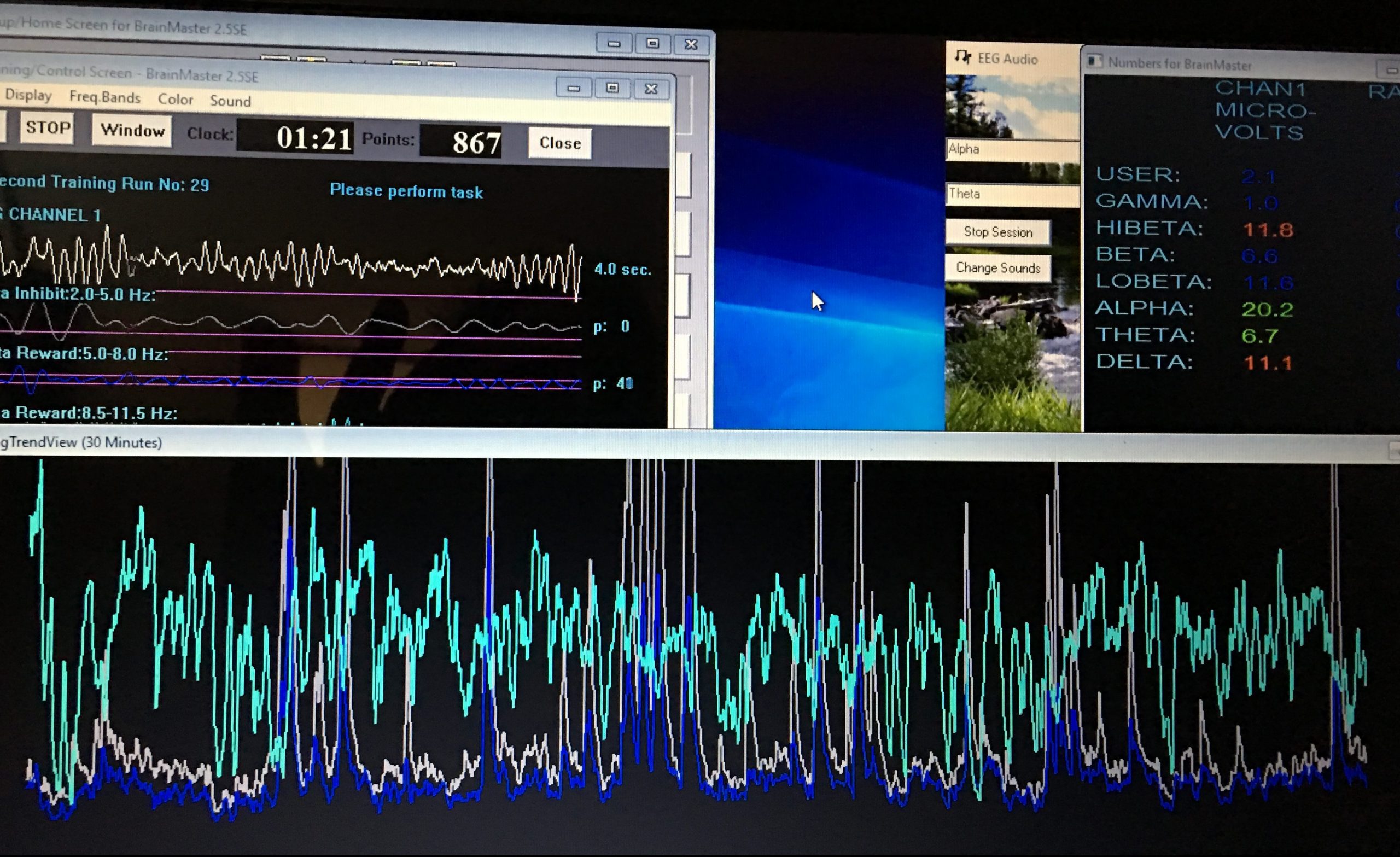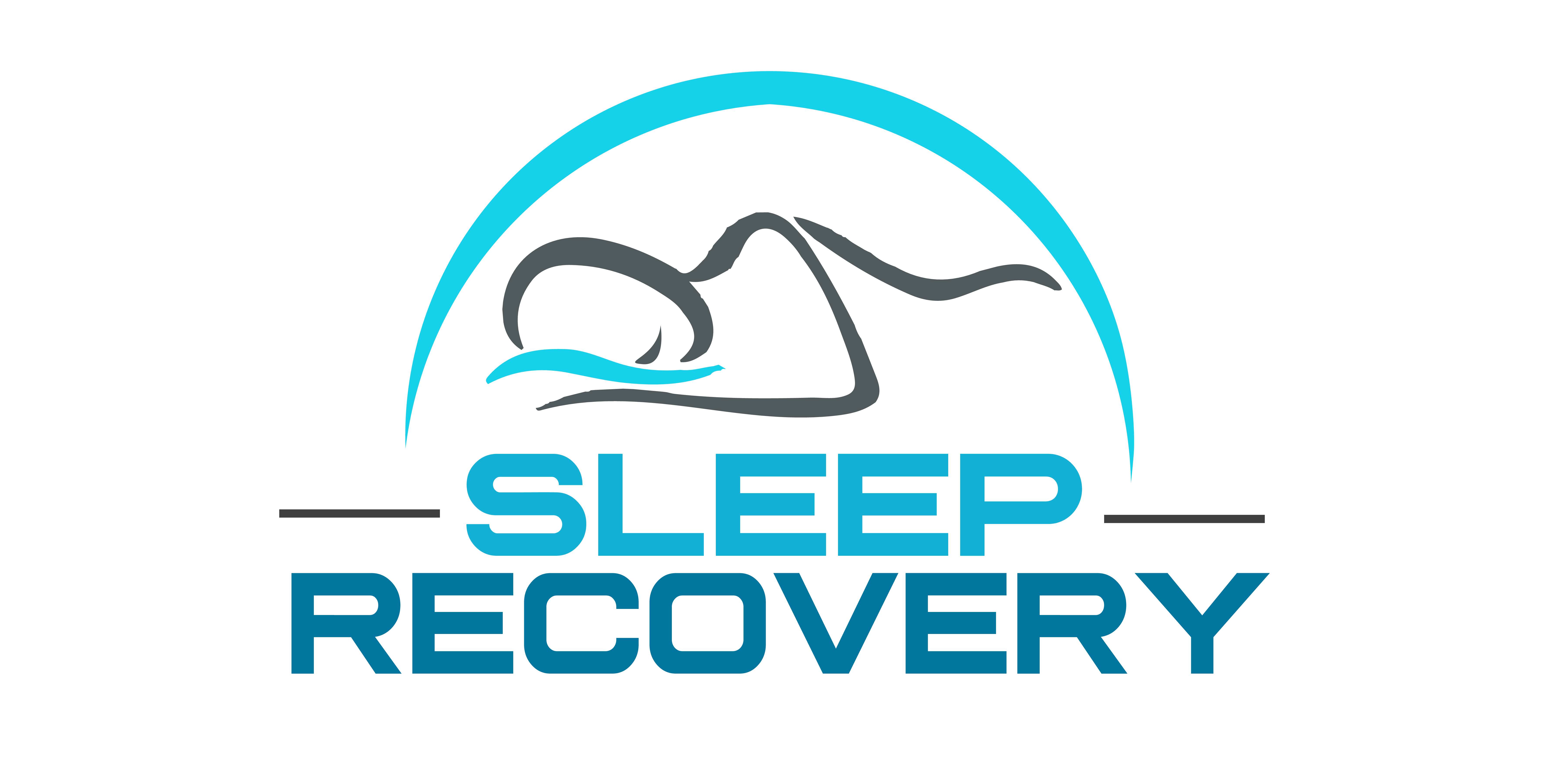Trauma Test: How Alpha-Theta Neurofeedback Detects EEG Signatures in the Deep Brain

Uncovering hidden trauma patterns with an approach that goes beyond traditional therapy methods
Many trauma victims feel stuck in patterns that won’t change, no matter how much they understand them intellectually. For many people living with unresolved trauma, this experience is all too familiar. Talk therapy helps name the problems, but sometimes can’t seem to shift them to a deeper level.
Recent advances in neuroscience have revealed why: trauma doesn’t just live in our conscious thoughts—it creates distinct electrical patterns in our brains that remain active below our awareness. These patterns can disrupt sleep, trigger stress responses, and maintain anxiety cycles even when we’re actively trying to heal.
Alpha-theta neurofeedback offers a window into these hidden brain patterns and, more importantly, a method for reshaping them. By creating what practitioners call a “twilight state” between wakefulness and sleep, this specialized approach accesses parts of the brain typically beyond our conscious reach.
The Brain States Between Waking and Dreaming
To understand how Alpha-Theta neurofeedback works, we first need to understand brain waves. Your brain constantly generates electrical activity in different frequency ranges or “waves” that correspond to varying states of consciousness:
Beta waves (13-30 Hz) dominate when you’re alert, thinking, and problem-solving.
Alpha waves (8-12 Hz) increase when you close your eyes and relax, indicating a calm but awake state.
Theta waves (4-7 Hz) emerge as you drift toward sleep or during deep meditation. They represent a dreamlike state in which the subconscious becomes more accessible.
Delta waves (0.5-4 Hz) predominate during deep sleep.
“Alpha-Theta training creates a bridge between our conscious and subconscious minds,” explains David Mayen, Founder and Program Director at Sleep Recovery. “We help the brain sustain a pattern where Alpha waves gradually transition to Theta without falling asleep. This unique approach creates a unique state where the thinking mind quiets while the deeper, emotional brain becomes more accessible.”
This “twilight state” has remarkable properties. Research shows it can:
- Access emotional memories stored in the limbic system
- Allow processing of feelings without triggering overwhelming responses
- Bypass the cognitive filters that often block trauma healing
- Strengthen connections between brain regions disrupted by trauma
Trauma’s Hidden Patterns: What the EEG Reveals
When someone experiences trauma, the brain creates protective patterns that endure long after the danger has passed. These patterns show up as distinct EEG signatures that conventional methods often miss.
“The traumatized brain shows specific abnormalities in its electrical patterns,” notes Dr. Jeffery Wilson, Clinical Director at Sleep Recovery. “We frequently see excessively high-frequency activity in regions associated with vigilance and threat detection, alongside disrupted Alpha rhythms that normally indicate relaxation.”
Perhaps most telling is how trauma affects Theta waves—the rhythms that Alpha-Theta neurofeedback targets. Research shows that people with trauma histories often display irregular Theta patterns during the transition to sleep, which correlates with their reports of sleep disturbances and nightmares.
A groundbreaking study published in Brain Topography found that Alpha-Theta neurofeedback increased connectivity in the brain’s Default Mode Network (DMN)—a system critical for self-reflection and emotional processing that often functions abnormally in people with trauma histories.
The research team, led by Claudio Imperatori, observed that participants who received Alpha-Theta training showed significant improvements in mentalization—the ability to understand one’s mental states and those of others. This improvement corresponded with increased activity in the posterior cingulate cortex, a key DMN region.
The Sleep Recovery Method: Accessing the Traumatized Brain
Sleep Recovery’s approach to trauma uses Alpha-Theta neurofeedback in a carefully structured protocol that differs from many conventional applications. Their method addresses the brain’s electrical patterns and the sleep disruptions that almost always accompany trauma.
“The connection between trauma and sleep troubles isn’t coincidental—they’re different expressions of the same neurological disruption,” explains Mayen. “By addressing both simultaneously, we can break cycles that otherwise tend to reinforce each other.”
The Sleep Recovery protocol typically includes:
Assessment Phase: Detailed sleep history combined with brain mapping to identify specific EEG patterns associated with the individual’s trauma response.
Stabilization Training: Initial sessions focus on relaxation and stress reduction to prepare the nervous system for deeper work.
Alpha-Theta Sessions: Specialized training to help the brain produce the Alpha-Theta crossover pattern while maintaining a relaxed but conscious state.
Integration Support: Guidance on processing emotional material that emerges during sessions, emphasizing creating new neural pathways.
Sleep Consolidation: Specific techniques to help the brain transfer insights from Alpha-Theta sessions into improved sleep architecture.
During a typical Alpha-Theta session, clients recline comfortably with their eyes closed while sensors monitor their brainwave patterns. Gentle audio feedback—usually in natural sounds or musical tones—reflects moment-by-moment changes in brain activity. The feedback grows stronger when the brain produces more Alpha and Theta waves in the desired pattern.
As sessions progress, most clients report experiencing vivid imagery, emotional insights, and spontaneous memories—often including aspects of past experiences that weren’t accessible through talking alone.
Real Stories, Real Results
James, a combat veteran who struggled with both trauma symptoms and insomnia for over a decade, described his experience with Alpha-Theta neurofeedback as “finally finding the reset button.”
“I’d tried everything—meditation, exposure therapy, sleep medications, you name it,” he recalls. “They all helped somewhat, but I felt like part of my brain was permanently stuck in combat mode. During my third Alpha-Theta session, something shifted. I saw vivid images from my deployment, but instead of feeling terrified or numb like usual, I could observe them with a sense of distance and clarity. That night, I slept for six hours straight—the first time in years.”
This combination of emotional processing and improved sleep is typical. Rachel, who developed severe insomnia after a car accident, noticed changes even more quickly.
“After just two sessions, my sleep tracker showed I was getting almost double the deep sleep I had been before,” she notes. “The nightmares didn’t stop immediately, but they changed—they became less vivid and frightening, and I could fall back asleep afterward instead of staying up all night.”
Research supports these anecdotal reports. A Clinical EEG and Neuroscience study found that Alpha-Theta neurofeedback significantly reduced trauma symptoms, with improvements still present at 30-month follow-up. Particularly striking was the finding that participants showed normalized brain activity patterns during sleep, suggesting fundamental changes in how the brain processes traumatic memories.
Beyond Trauma: Additional Benefits of Alpha-Theta Training
While trauma healing represents a significant application of Alpha-Theta neurofeedback, its benefits extend to many other areas. The same “twilight state” that allows trauma processing also creates enhanced creativity, performance, and general well-being conditions.
Creativity Enhancement
Artists, writers, and musicians have reported significant creative breakthroughs during and after Alpha-Theta training. A study at London’s Royal College of Music found that music students who received Alpha-Theta neurofeedback showed marked improvements in artistic performance compared to controls.
“The Alpha-Theta state closely resembles what’s sometimes called ‘flow state’ or being ‘in the zone,'” explains Dr. Wilson. “By helping the brain access this state intentionally, we can strengthen neural pathways associated with creative thinking and artistic expression.”
Peak Performance
Athletes and executives increasingly use Alpha-Theta training to enhance focus, reduce performance anxiety, and improve recovery. The protocol allows for mental rehearsal in a deeply receptive state, helping strengthen neural connections associated with optimal performance.
Michael, a professional golfer who struggled with tournament anxiety, found that just eight Alpha-Theta sessions produced lasting changes. “My mind used to race before important shots, reviewing everything that could go wrong,” he recalls. “After the training, I could immediately access this calm, focused state. My coach said my swing looked more fluid than he’d ever seen it.”
Sleep Architecture Improvement
Perhaps most relevant to Sleep Recovery’s work is how Alpha-Theta training improves sleep quality even for those without trauma histories. Many clients report more profound, restorative sleep with fewer awakenings and more consistent sleep cycles.
“Alpha-Theta training essentially helps strengthen the brain’s natural transition into sleep,” notes Mayen. “By practicing this transition while conscious during neurofeedback, the brain becomes more efficient at producing these patterns when falling asleep.”
Distinguishing Alpha-Theta from Other Approaches
Alpha-Theta neurofeedback offers several unique advantages compared to other trauma treatments:
Non-verbal Processing: Unlike talk therapy, Alpha-Theta doesn’t require putting traumatic experiences into words, making it valuable for preverbal or complex trauma.
Gentler Approach: Unlike exposure therapies, Alpha-Theta doesn’t trigger intense reliving of traumatic events, reducing the risk of re-traumatization.
Physiological Focus: Alpha-Theta addresses the underlying neurological patterns maintaining trauma responses rather than directly targeting thoughts or behaviors.
Simultaneous Sleep Improvement: Alpha-Theta can break cycles that otherwise reinforce each other by addressing trauma and sleep disruption.
However, Alpha-Theta isn’t appropriate for everyone. The best candidates typically have:
- Some existing ability to self-regulate emotions
- A stable support system
- No active substance abuse issues
- No severe dissociative tendencies
- Previous experience with some form of trauma processing
For those who aren’t yet ready for Alpha-Theta work, Sleep Recovery offers preliminary stabilization training to build the necessary skills.
The Neuroscience Behind Alpha-Theta’s Effectiveness
Recent advances in neuroscience help explain why Alpha-Theta neurofeedback can succeed where other approaches sometimes fall short. Three key mechanisms appear particularly important:
1. Default Mode Network Recalibration
The Default Mode Network (DMN) is a brain system that activates when we’re not focused on external tasks—essentially, our brain’s “default” state for self-reflection and internal processing. Trauma disrupts DMN functioning, often leaving people either disconnected from their internal experience or overwhelmed by it.
Alpha-Theta training has been shown to normalize DMN connectivity. A recent study found increased functional connectivity between key DMN regions following Alpha-Theta neurofeedback, correlating with an improved ability to understand and process emotions.
2. Memory Reconsolidation
When we recall a memory, it briefly becomes malleable before being “reconsolidated” or stored again. The Alpha-Theta state provides ideal conditions for memory reconsolidation, allowing traumatic memories to be reprocessed with less emotional charge before being stored again in modified form.
3. Fear Network Desensitization
Trauma creates hyperactive fear networks in the brain that trigger stress responses even to non-threatening stimuli. The deeply relaxed state produced during Alpha-Theta training allows exposure to feared memories without triggering these networks, gradually reducing their reactivity through a process similar to extinction learning.
The Sleep Recovery Approach: Personalized Protocols
Sleep Recovery’s implementation of Alpha-Theta neurofeedback is distinguished by its personalized approach. Rather than applying a standardized protocol to all clients, they customize training based on individual EEG patterns and trauma histories.
“No two traumatized brains look exactly alike,” notes Dr. Wilson. “Some people show hyperarousal patterns, others show dissociative patterns, and many show a combination that fluctuates over time. Effective treatment requires targeting the specific patterns present in each individual.”
This personalization extends to the feedback itself. While some clients respond best to natural sounds like ocean waves or rainfall, others benefit more from musical tones or visual feedback displayed through light patterns with their eyes closed.
The typical course of treatment at Sleep Recovery includes 15-20 sessions, though some clients notice significant improvements after as few as 5-6 sessions. Most clients attend sessions twice weekly.
Is Alpha-Theta Right for You?
If you’re considering Alpha-Theta neurofeedback for trauma or sleep issues, ask yourself:
- Do I have trauma symptoms that haven’t fully resolved with traditional therapy?
- Do I struggle with sleep problems alongside emotional difficulties?
- Am I ready to experience emotional material that might emerge during training?
- Can I commit to a series of sessions over several weeks?
If you answered yes to these questions, Alpha-Theta neurofeedback might be worth exploring as part of your healing journey.
“What makes Alpha-Theta so powerful is its ability to access parts of the brain that talk therapy alone can’t reach,” says Mayen. “Words are processed primarily by the conscious, cognitive brain, while trauma lives deeper in the emotional and body-memory systems. Alpha-Theta bridges these systems, allowing healing to occur at a fundamental neurological level.”
Conclusion: Healing at the Source
Alpha-Theta neurofeedback represents a significant advance in trauma treatment by addressing the electrical brain patterns that maintain trauma responses below conscious awareness. By creating a unique “twilight state” between waking and sleeping, this approach accesses trauma’s hidden signatures and helps the brain develop healthier patterns.
What makes Sleep Recovery’s implementation particularly effective is its integration of trauma processing with sleep improvement, addressing two interrelated problems through a comprehensive approach. The results speak for themselves: clients regularly report improvements not just in trauma symptoms but in sleep quality, emotional regulation, creativity, and overall well-being.
For those who have struggled with trauma’s lingering effects despite years of traditional therapy, Alpha-Theta neurofeedback offers a path to healing that works with the brain’s natural processes rather than fighting against them. Detecting and reshaping trauma’s deep brain signatures addresses the symptoms and the source, creating the possibility for genuine and lasting transformation.
For more information on Alpha-Theta neurofeedback for trauma and sleep issues, contact Sleep Recovery at 1-800-927-2339 or visit https://sleeprecovery.net.
References:
- An Alpha and Theta Intensive and Short Neurofeedback Protocol for Healthy Aging Working-Memory Training. https://www.frontiersin.org/journals/aging-neuroscience/articles/10.3389/fnagi.2016.00157/full
-
Comparison of Alpha-Theta, Alpha, and EMG Neurofeedback in the Production of Alpha-Theta Crossover and the Occurrence of Visualizations. Visualizations.https://www.isnr-jnt.org/article/view/17201/0
-
Why YOU should be doing Alpha/Theta training. https://www.alternative-therapeutics.com/blog/2020/7/28/why-you-should-be-doing-alphatheta-training
-
EEG Signature and Phenomenology of Alpha/theta Neurofeedback Training Versus Mock Feedback. https://link.springer.com/article/10.1023/A:1021063416558


